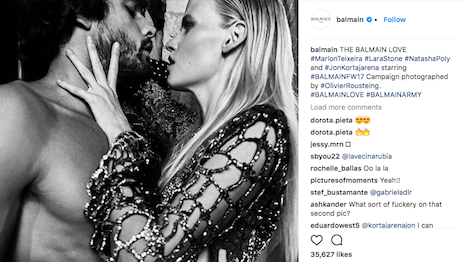
Chanel fall/winter 2017 features Gen Z's Lily-Rose Depp and millennial Cara Delevingne. Image credit: Chanel
By Mickey Alam Khan
NEW YORK - As the role of physical stores has changed, bricks-and-mortar is starting to stabilize with a 1 percent growth in store-only shopping, according to Boston Consulting Group.
During the Women in Luxury 2018 conference on May 9, an analyst from BCG explained that despite past research, millennials are now the most loyal generation group. Another major shift is the jump in consumers who claimed to have shopped only at bricks-and-mortar, despite a steep decline the past few years.
“Omnichannel is something we’ve been tracking for the last few years,” said Sarah Willersdorf, partner and managing director at Boston Consulting Group. “You can see in 2014 versus 2015, for last purchases tracked, whether that be online, showrooming, ROPO or store solo, you can see omnichannel has increased.
“But between 2016 and 2017, store only has jumped up a bit,” she said. “That’s really interesting because it was really coming down quite dramatically, but now it has stabilized.”
Women in Luxury 2018 was organized by Luxury Daily, with venue sponsor UBS
Retail research
Experts, marketers and retailers have been discussing and focusing on millennials for a significant time period, causing many to believe this segment is overhyped.
But the numbers prove this is not true. Millennials are set to become 50 percent of the market in approximately five years.
These shoppers are getting older, they are spending more and they are more loyal then any other segment. They value extravagance and fun, and are looking to be unique.
Chinese consumers will be joining millennials in driving the market.
 Secoo wants to drive up sales among tech-savvy Chinese women. Image credit: Secoo
Secoo wants to drive up sales among tech-savvy Chinese women. Image credit: Secoo
Ms. Willersdorf also explained that capturing growth is becoming more expensive. The need to invest in marketing and consumer engagement is much more important today, and is growing.
There is no longer one big competitor to compete with, but many smaller companies who are able to outsource a lot of their businesses.
Social media has been one of the top influencers for purchasing decisions the last few years, but last year it was the most important driver.
However, magazines are still listed as the second top purchase driver, across a variety of markets.
YouTube is becoming less influential for purchases, and Instagram is noted as much more important that Facebook.
 Balmain shows love for Instagram. Image credits: Balmain and Instagram
Balmain shows love for Instagram. Image credits: Balmain and Instagram
Ms. Willersdorf also noted that consumers’ price-point purchases are changing. Affluent consumers are trading down, mixing and matching high-end and low-end clothing and accessories, while mass-market consumers are also trading up.
Additional insight
Many of the problems that caused luxury growth to stagnate over the last few years are challenges largely created by the business itself instead of outside forces, according to other research from Boston Consulting Group.
Speaking at Luxury FirstLook 2018: Exclusivity Redefined on Jan. 17, an executive from BCG spoke about the differences between the generations when it comes to luxury shopping and behavior. What BCG found was that the concept of trading up and trading down was very popular among millennials as a means of purchasing products outside their normal range (
see more).
While marketing spend on digital advertising is quickly overtaking television spend, a report from Boston Consulting Group and Facebook shows that those that tap data are more successful.
Marketers that invest in long-term interactive relationships with consumers, which seamlessly span multiple platforms, are seeing better results than those using the “spray-and-pray” method. Brands need to tap real-time feedback from consumers and invest in varying concepts (
see more).
“Capturing growth is now more expensive,” Ms. Willersdorf said. “The need to invest more in marketing and the need to engage with consumers has increased.
“We also see it become even more highly fragmented, as the boundaries increase across apparel, luxury real estate, etc.,” she said. “We don’t see one big competitor coming in and stealing your lunch but a lot of small ones.”
 Chanel fall/winter 2017 features Gen Z's Lily-Rose Depp and millennial Cara Delevingne. Image credit: Chanel
Chanel fall/winter 2017 features Gen Z's Lily-Rose Depp and millennial Cara Delevingne. Image credit: Chanel
 Secoo wants to drive up sales among tech-savvy Chinese women. Image credit: Secoo
Secoo wants to drive up sales among tech-savvy Chinese women. Image credit: Secoo Balmain shows love for Instagram. Image credits: Balmain and Instagram
Balmain shows love for Instagram. Image credits: Balmain and Instagram